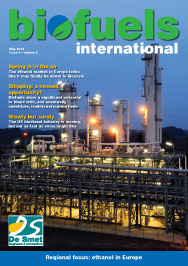
Volume 6, Issue 4
Published: May 7, 2012
Millbrook and CONCAWE open the door to 10% ethanol blends
L ast year CONCAWE, the oil companies’ European research association, based in Brussels, Belgium, began a one-year passenger car test programme on 10% ethanolpetrol blends in order to test their...
Slowly but surely
It is still early in the year, but the US biodiesel industry seems headed for little demand growth in 2012 compared with a year prior when domestic production facilities recorded output of 1.1 billion...
Explaining high fuel prices
Consumers across the US are now paying close to $4 (€3) for a gallon of petrol. Prices at the pump are directly tied to world oil prices for the very simple reason that there is a lack of competition...
US cellulosic ethanol mandate under attack
On 9 March 2012 the API, which represents more than 500 oil and natural gas companies, filed a lawsuit in the DC Circuit Court challenging the Environmental Protection Agency’s 2012 requirements...
Plant to showcase technology for worldwide use
Italy’s biofuels market started slowly. Competition from South America, and confusing EU and Italian legislation delayed growth. The industry has been struggling to meet its EU 2020 mandatory 10%...
Spring is in the air
Spring is here in the UK, and as the lambs gambol and the birds sing overhead, a distant rumble can be heard through the countryside of northeast England. Grain trucks are beginning their pilgrimage to...
Wheat for bioethanol â
When it comes to wheat processing plants, bioethanol certainly hits the mega-league for size. An average flour miller or animal feed compounder might use 50–200,000 tonnes of wheat per annum, with...
Wheat supply, demand and pricing trends
There are some compelling conclusions that can be drawn from the trends of the last 10-15 years. First, wheat production has risen due to an upward trend in average crop yield and increasing acreage in...
Biofuels + biochemicals = brighter future
Biofuels technology company Solazyme, based in San Francisco, stumbled across a discovery in January that its technology could not only create biofuels but chemicals that could be used for skincare. ...
It is all about chemistry
Bio-based plastics, chemicals and fuels are gradually penetrating our daily life. Increasing oil prices, medium- to long-term scarcity and a national urge for oil independency led governments across the...
Going full circle
A lubricant is a substance, either fluid, semi-fluid or solid, introduced between two moving surfaces to reduce friction. The primary purpose of any lubricant is to reduce wear and heat between the contacting...
Shipping: a missed opportunity?
Ocean-going ships consume a significant part of global transportation fuels. Although commercial shipping is, by far, the most energy efficient mode of transporting goods around the world, the global shipping...
The path to becoming a low cost producer
In an unpredictable market, partly created and limited by government mandates, plagued with operational inefficiencies and limited ability to process less expensive feedstock, low-cost producers have a...
Clean before, not after, storage
Up until now, almost all filtration systems installed on bulk fuel storage tanks were placed between the tank and the fuel dispenser downstream of the tank. Whilst filtering at this location is important,...
Tried and tested
Membranes are highly engineered, physical barriers that are used in processes for liquid/liquid and liquid/solid separation. They permit the passage of materials only up to a certain size, shape or character....
The project finance market â
More than 60% of the 87 million barrels of oil consumed every day power the world’s transportation sector, and liquid fossil fuels account for 94% of the energy supply to the sector.1 The...
The role of the project consultant
Those involved with building plants do not see their project from the same viewpoints as their lenders or investors, and neither has the same perspective as other project participants. Lawyers, for example,...










